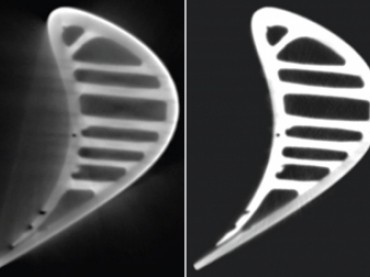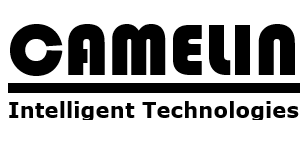
For production process control of complex and expensive components, Computed Tomography (CT) becomes the technology of choice for many inspection and metrology tasks, e.g. for automotive castings, aerospace turbine blades or 3D printed parts which by nature have hidden features. A major challenge is the increased cycle time requirements combined with high inspection depth which requires improved methods to deal with imaging artefacts.
Scattering of X-rays is the main factor for such artefacts in CT. While state of the art scatter reduction simulates scatter based on CAD data or sample’s material properties, GE’s proprietary scatter|correct technology is really measuring the scatter portion of that specific sample in the CT scanner and minimizes it from the CT result for every individual voxel. The new method drives inspection throughput and precision of high energy CT applications to scan difficult to penetrate samples with a relatively high atomic number such as metals which are actually performed with highly collimated classical 2D fan beam CT. It allows customers to gain CT quality never before reached with industrial flat panel based cone beam CT. By combining high precision fan beam CT quality with the up to 100 times higher throughput of fully automated cone beam CT, the significantly increased inspection productivity allows CT to migrate from R&D applications to serial inspection on the production floor.
The new method will not only substitute slower fan beam minifocus CT in many application cases: in many application cases 300 kV microCT scans can now be applied for inspection tasks were normally the investment in more expensive 450 kV high energy CT equipment would be required.
Advanced scatter correction technology also increases measurment prescision: 3D metrology with CT always uses automatic surface detection algorithms to determine the surface of the 3D volume to measure. Compared to conventional cone beam CT the new method allows more material penetration (up to 30%) at the same scan parameters to still determine the exact surface. At same material penetration length, the new scatter correction method allows a more precise surface detection due to less artifacts negatively affecting the metrology results.
Worlds first industrial minifocus CT scanner available with GE’s new scatter|correct option is the phoenix v|tome|x c 450 series, the first microCT system is the phoenix v|tome|x m scanner.
- Low artifact high precision performance of fan beam CT combined with up to 100 times faster* inspection speed of cone beam CT
- Provides significant quality improvement not only for high scattering materials such as steel and aluminium, but also for composites and multi material samples
- Clearly improved quantitative volume evaluation, e.g. automatic defect recognition or precise 3D metrology of difficult to penetrate multimaterial objects
- Proprietary GE technology – exclusively available as option for the industrial mini- and microCT scanner phoenix v|tome|x c and m as well as upgrade package for installed m systems
- CT scans can be performed with less energy reducing the need for more expensive higher energy tubes and systems
- Many application cases can be performed with 300 kV microCT scans were others need to invest in more expensive 450 kV high energy CT equipment
While a typical fan beam CT scan of 1000 slices requires 1 minute per slice = 1000 minutes, a cone beam CT scan requires only 10 minutes
– See more at: www.gemeasurement.com
